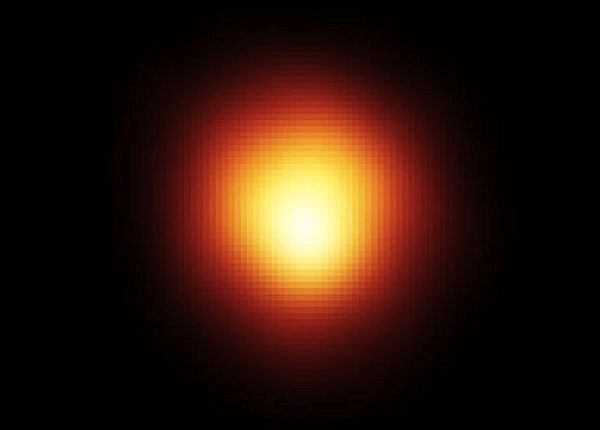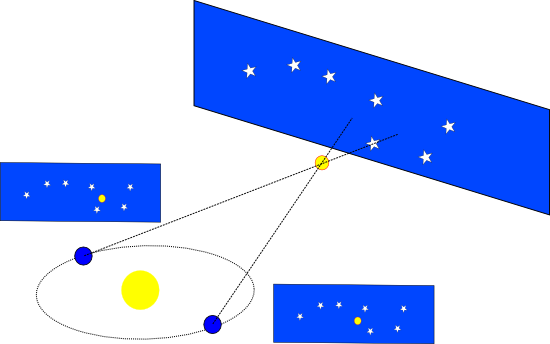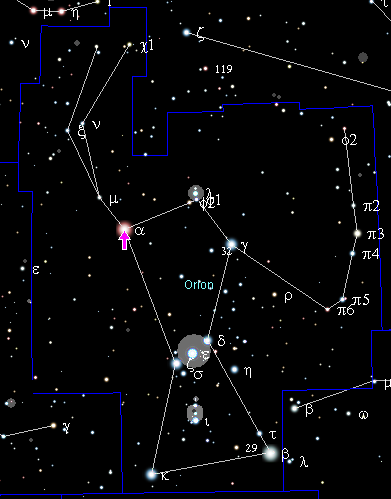
The star Betelgeuse, as seen in ultraviolet light by the Hubble Space Telescope. The bright white spot is likely one of this star’s poles. Image via NASA/ESA.
Not long after I first wrote for EarthSky about the possibility that the star Betelgeuse might explode someday, I realized that the distance I used for Betelgeuse – ninth-brightest star in the night sky and second-brightest in the constellation Orion the Hunter – had become outdated. So here’s a brief word about how star distances are determined (which also corrects that earlier distance estimate for Betelgeuse). Truth is, finding the distances to even the nearest stars is not easy.
Ancient Greek astronomers knew how to find distances for the nearest stars, but they couldn’t actually do it, because they lacked the technology. Oddly enough, many people use something like this same concept – the concept of parallax, used to find distances to the nearby stars – every day without ever thinking about it.

Your point of view makes a difference! Photo via CfA.
Here’s what we do, on a human scale. Hold your thumb out at arms’ length and look at it with just one eye. Note the apparent position of your thumb with respect to the background, say a fence in your backyard, a row of distant trees or buildings. Then quickly switch to the other eye. You should note that your thumb seems to jog slightly to one side or the other.
That’s because you are looking at your thumb with your two different eyes separated by a couple of inches (or centimeters), seeing a slightly different view with each.
Normally our brains consolidate the two views, and that’s why we have stereoscopic vision and depth perception. The brain calculates distances based on how much the view differs. It’s similar to how a surveyor can measure the distance to some object using triangulation.
Our brains do this automatically.
Example of triangulation. Mathematically, if you can measure the parallax angle of some object when viewed from two different locations separated by a known distance, you can calculate the distance to the object. Image via Wikimedia Commons.
The ancients thought, correctly, that this concept could be used to determine the distances to stars. Instead of using the views from two human eyes, they chose to make separate observations from two different locations.
But the ancient astronomers could not make it work. No matter how far they extended the distance between the two observations, the view from one place looked exactly the same as a view from another. They failed, but they concluded correctly that the angle must be very small, and the stars very, very far away!
All measurements of stellar parallax (and determination of the distances to stars) failed until German astronomer Friedrich Bessel succeeded in 1838. Instead of just his eye, he used a telescope. And instead of the distance between his eyes, his baseline was the diameter of the Earth’s orbit.
He accomplished this huge baseline by measuring once, and then again 6 months later when the Earth was on the other side in its orbit, a distance of roughly 186 million miles (300 million km).
Even then, he was barely able to make out a tiny angular displacement. But it was enough to determine a distance of 11 light-years to a nearby star called 61 Cygni.
Enjoying EarthSky so far? Sign up for our free daily newsletter today!

When using the technique of stellar parallax to find star distances, it’s possible to use the orbit of Earth as a baseline. Illustration via Wikipedia.
From Bessel’s time until the 1980s, only a few thousand parallaxes had been determined. The process is hindered by a number of factors including the extremely small angles involved, imperfections in the instruments and perhaps most of all, the murkiness of Earth’s own atmosphere. Observations from the Earth, even from very clear and dark locations such as deserts and mountaintops, are blurred by distortions from the atmosphere. It’s a bit like looking up from the bottom of a swimming pool.
In 1989, the European Space Agency (ESA) launched a satellite with a telescope above the Earth’s blurry blanket of air. It was called Hipparcos, named after the famed Greek astronomer Hipparchus, who applied trigonometry to the problem of stellar distances more than 2,000 years ago.
Over several years of observations, Hipparcos provided parallax and distance data for more than 100,000 relatively nearby stars.
This brings me back to the reason for this post. The original Hipparcos data gave a parallax of Betelgeuse of 7.63 milliarcseconds, which is about one-millionth the width of a full moon. This equates to a distance for Betelgeuse of about 430 light-years.
Subsequent studies found an error in the methods of reducing data for variable stars such as Betelgeuse. One effort to correct those errors gives 5.07 milliarcseconds. Using this figure, Betelgeuse is about 643 plus or minus 46 light-years. This is likely the most accurate current estimate to date, and its the distance that Google will show you if you write “distance to Betelgeuse” in a Google search bar.
So measuring star distances is – still – hard.
But consider that space is vast, and the objects in space are tiny in comparison. To give a sense of scale here, if our sun were the size of a pellet used in a BB gun, Betelgeuse would be roughly the size of a Toyota Camry, and located nearly 12,500 miles (20,000 km) away!

Betelgeuse is the second-brightest star in the well-known constellation Orion the Hunter, which is well placed for viewing in the evening sky from about December to March each year.
Enjoying EarthSky? Sign up for our free daily newsletter today!
Bottom line: Finding the distances to even the nearest stars is not easy. Here’s how it’s done, and why the distance to the famous star Betelgeuse had to be modified from 430 light-years to 643 light-years (plus or minus 46 light-years).
from EarthSky http://ift.tt/1AQuHfA

The star Betelgeuse, as seen in ultraviolet light by the Hubble Space Telescope. The bright white spot is likely one of this star’s poles. Image via NASA/ESA.
Not long after I first wrote for EarthSky about the possibility that the star Betelgeuse might explode someday, I realized that the distance I used for Betelgeuse – ninth-brightest star in the night sky and second-brightest in the constellation Orion the Hunter – had become outdated. So here’s a brief word about how star distances are determined (which also corrects that earlier distance estimate for Betelgeuse). Truth is, finding the distances to even the nearest stars is not easy.
Ancient Greek astronomers knew how to find distances for the nearest stars, but they couldn’t actually do it, because they lacked the technology. Oddly enough, many people use something like this same concept – the concept of parallax, used to find distances to the nearby stars – every day without ever thinking about it.

Your point of view makes a difference! Photo via CfA.
Here’s what we do, on a human scale. Hold your thumb out at arms’ length and look at it with just one eye. Note the apparent position of your thumb with respect to the background, say a fence in your backyard, a row of distant trees or buildings. Then quickly switch to the other eye. You should note that your thumb seems to jog slightly to one side or the other.
That’s because you are looking at your thumb with your two different eyes separated by a couple of inches (or centimeters), seeing a slightly different view with each.
Normally our brains consolidate the two views, and that’s why we have stereoscopic vision and depth perception. The brain calculates distances based on how much the view differs. It’s similar to how a surveyor can measure the distance to some object using triangulation.
Our brains do this automatically.
Example of triangulation. Mathematically, if you can measure the parallax angle of some object when viewed from two different locations separated by a known distance, you can calculate the distance to the object. Image via Wikimedia Commons.
The ancients thought, correctly, that this concept could be used to determine the distances to stars. Instead of using the views from two human eyes, they chose to make separate observations from two different locations.
But the ancient astronomers could not make it work. No matter how far they extended the distance between the two observations, the view from one place looked exactly the same as a view from another. They failed, but they concluded correctly that the angle must be very small, and the stars very, very far away!
All measurements of stellar parallax (and determination of the distances to stars) failed until German astronomer Friedrich Bessel succeeded in 1838. Instead of just his eye, he used a telescope. And instead of the distance between his eyes, his baseline was the diameter of the Earth’s orbit.
He accomplished this huge baseline by measuring once, and then again 6 months later when the Earth was on the other side in its orbit, a distance of roughly 186 million miles (300 million km).
Even then, he was barely able to make out a tiny angular displacement. But it was enough to determine a distance of 11 light-years to a nearby star called 61 Cygni.
Enjoying EarthSky so far? Sign up for our free daily newsletter today!

When using the technique of stellar parallax to find star distances, it’s possible to use the orbit of Earth as a baseline. Illustration via Wikipedia.
From Bessel’s time until the 1980s, only a few thousand parallaxes had been determined. The process is hindered by a number of factors including the extremely small angles involved, imperfections in the instruments and perhaps most of all, the murkiness of Earth’s own atmosphere. Observations from the Earth, even from very clear and dark locations such as deserts and mountaintops, are blurred by distortions from the atmosphere. It’s a bit like looking up from the bottom of a swimming pool.
In 1989, the European Space Agency (ESA) launched a satellite with a telescope above the Earth’s blurry blanket of air. It was called Hipparcos, named after the famed Greek astronomer Hipparchus, who applied trigonometry to the problem of stellar distances more than 2,000 years ago.
Over several years of observations, Hipparcos provided parallax and distance data for more than 100,000 relatively nearby stars.
This brings me back to the reason for this post. The original Hipparcos data gave a parallax of Betelgeuse of 7.63 milliarcseconds, which is about one-millionth the width of a full moon. This equates to a distance for Betelgeuse of about 430 light-years.
Subsequent studies found an error in the methods of reducing data for variable stars such as Betelgeuse. One effort to correct those errors gives 5.07 milliarcseconds. Using this figure, Betelgeuse is about 643 plus or minus 46 light-years. This is likely the most accurate current estimate to date, and its the distance that Google will show you if you write “distance to Betelgeuse” in a Google search bar.
So measuring star distances is – still – hard.
But consider that space is vast, and the objects in space are tiny in comparison. To give a sense of scale here, if our sun were the size of a pellet used in a BB gun, Betelgeuse would be roughly the size of a Toyota Camry, and located nearly 12,500 miles (20,000 km) away!

Betelgeuse is the second-brightest star in the well-known constellation Orion the Hunter, which is well placed for viewing in the evening sky from about December to March each year.
Enjoying EarthSky? Sign up for our free daily newsletter today!
Bottom line: Finding the distances to even the nearest stars is not easy. Here’s how it’s done, and why the distance to the famous star Betelgeuse had to be modified from 430 light-years to 643 light-years (plus or minus 46 light-years).
from EarthSky http://ift.tt/1AQuHfA

Aucun commentaire:
Enregistrer un commentaire